Beautiful flower beds: layout features in landscape design
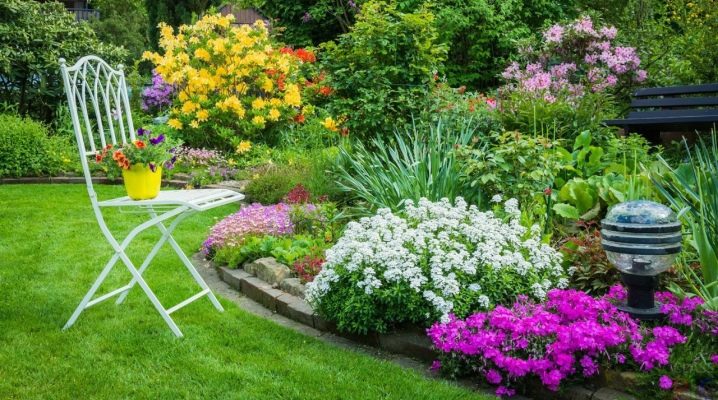
Flowers occupy one of the leading places in the design of any landscape design. They are placed on flower beds, which must be created taking into account the characteristics of each type of plant growing on them. These features will be discussed in this article.
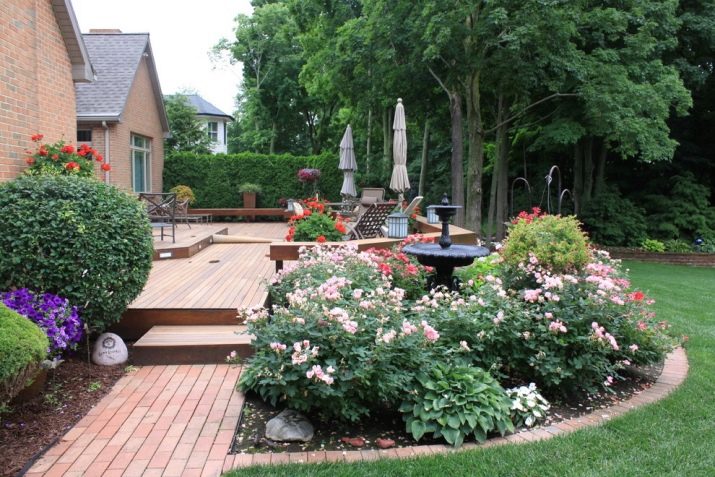
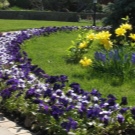
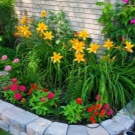
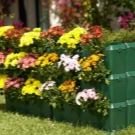
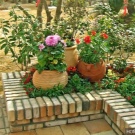
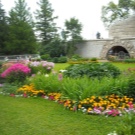
Peculiarities
The plot of each private house or adjacent territory has its own unique parameters. Before breaking up a flower bed, it is necessary to make an initial plan for the placement of future crops and plantings.

To correctly calculate the time of full ripening and flowering of planted seeds by the seasons, it is best to use ready-made layouts... They can be found in books on floristry or, if there is absolutely no desire to delve into this topic, use the services of a professional landscape designer.
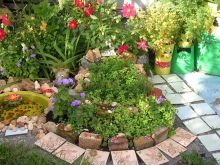
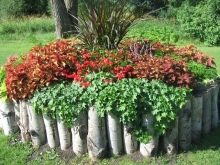
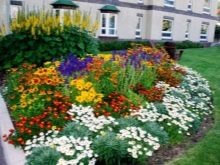
When planning the space of the land for the flower bed, you should also remember about your own convenience. The distance between the rows and easy access to each of them will ensure maximum comfort for the owner. This is very important because availability affects the full care of plants... In the case when a person cannot reach any of the beds, full and high-quality processing cannot be carried out, but only superficial.
Do not forget about the human factor. It may just get tired of reaching out and straining every time to remove fallen leaves or petals, as is often the case.
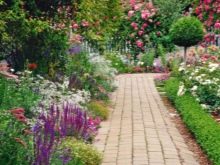
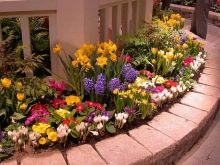
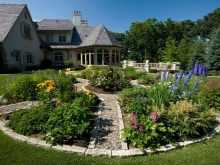
With the correct arrangement of plantings in the flowerbed, even on cold days, plants will delight you with their beauty. For example, among the snow, hellebore, western thuja, and dogwood can be full of greenery.
Autumn time is the season of colds. An excellent solution would be to grow medicinal plants in a flower bed, which will help to cope with the first symptoms of ailment. It would even be nice to set aside a separate "healing" flower bed. There you can grow chamomile, lavender, lemon balm, sage, calendula, thyme.

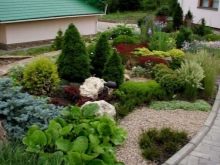
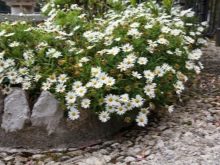
Very often, novice gardeners make a large number of mistakes, the most common of which is to plant all the flowers at random or on the "like it or not like it" principle. In this case the layering and proximity of plants can be disturbed... Due to the illiterate arrangement of flowers in height, shading of the space is possible, which will have a bad effect on the development of low-growing plants.
Do not forget about the soil. As a result of her wrong choice, the inflorescences will not be able to please their owner in all its glory.
Landscape designers are advised to zone the area of the flower bed. Thus, it is possible to achieve a combination of various types of flowers and shrubs without damaging each other.
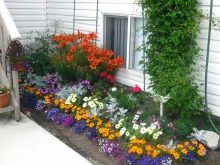

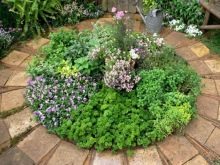
It is worth paying attention to such an issue as the timely cleaning of the land from faded inflorescences and weeds. Weeds spoil not only the appearance of the plantings, but also the very life of the root system and the flower as a whole. Systematic cleaning will help avoid problems with pests and natural debris, which is formed as a result of the life of flower beds.
It is very important to weed the beds in a timely manner so that there is no thick and coarse earth crust. If it is not removed in time, the roots will have nothing to breathe, and this can lead to the death of the root system and the flower in the future. The land should be well-groomed and loose.
An important aspect is seasonal soil fertilization. During growth and development, a seed or bulb feeds on macro and microelements that are in the ground. If it is rich enough in them, then the first shoots will not take long to wait, when it is meager and empty, the crops may not even sprout at all.

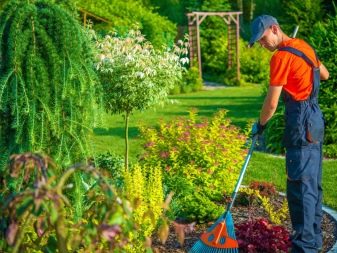
An excellent solution to save time and effort would be to maintain a flowering and harvesting calendar. According to him flowers need to be planted at short intervals - about a week... So the owner of the flower bed will have time to care for each species without haste and fuss, which will further instill a love for such a difficult task.
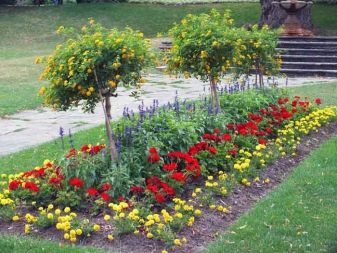
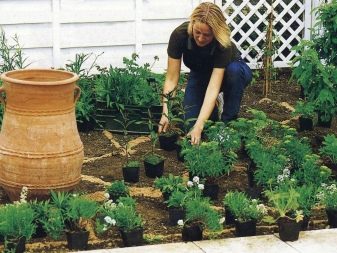
Types and forms
Today there is a wide variety of forms and types of flower beds, which delight with their uniqueness and originality.
First of all, you need to understand what a flower bed is. This is an artificially allocated piece of land, which has a clear shape, structure and a certain arrangement of flowers and shrubs. Most often, it occupies a dominant place in the overall picture of the flower garden. They can be divided into two types - floral and carpet.
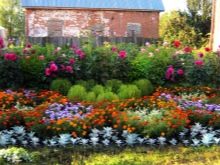
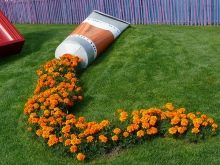
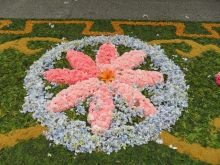
The flower bed is distinguished by the fact that both annual and perennial flowers and shrubs are planted on it, so it can bloom all year round. Of course, herbaceous or deciduous plants can be planted to add fluffiness and volume. It often has a multilevel structure and great species diversity.

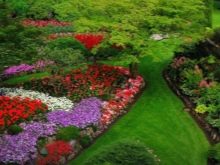
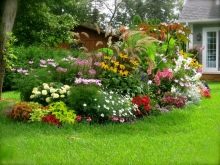
As for carpet beds, mainly flowers of the same color are planted here by height and flowering period. From the name it can be understood that they resemble a smooth carpet, in this regard, such a flower bed is often sheared so that the color canvas is even and well-groomed.
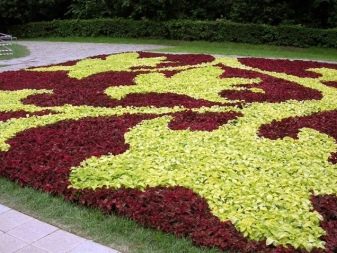
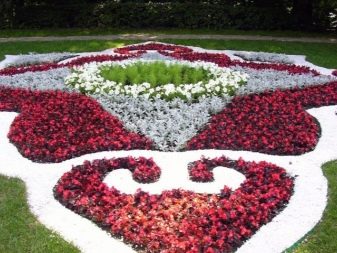
The following classification of flower beds is based on the flowering period of plants and shrubs. There are regular and irregular flower beds.
Regular ones are those that contain plants that bloom at the same time. As a rule, they have a rectangular, square or round shape, since the pattern must also repeat clear geometric shapes. Otherwise, such a flower bed will look rough and have a chaotic and uncomfortable pattern for the eyes.
It should be located in easily visible places, that is, not in the corner or at the edge of the site, but in the middle or in the center of the flower garden.

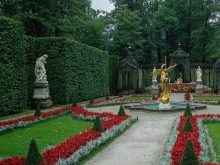
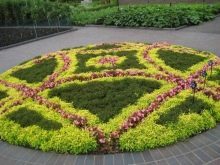
If this is an irregular flower bed, then here the preference is given to naturalness and proximity to nature. Flowers and shrubs are planted in small islands and can have a multi-level structure.
This type is most popular among florists and gardeners, since it is easy to care for it, it does not require much attention and time.
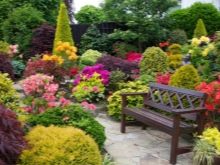

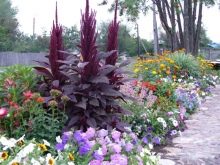
The raised flowerbed is unusual in its design. It is unique and interesting in that it can be multi-tiered, where each subsequent upward layer is separated by a wall of brick, decorative stone or wood and can have various shapes.
Semicircular and located around one axis (in the form of a triangular spring) tiered flower beds look very nice... In height, they can reach up to 1.5 m, ranging from 25-30 cm. It is convenient in that you do not need to bend too much when fertilizing, loosening and other care of the earth. You can just put a small bench and calmly care for the flower bed without stressing your back.
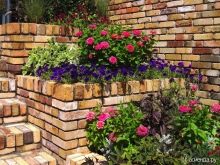
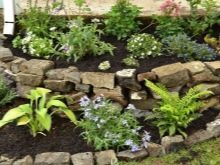
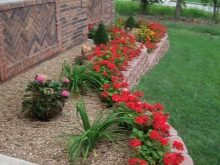
Not only simple flowers can be planted from plants, but also vegetable crops such as pumpkin or squash. Semi-ripe fruits will decorate and complement the flower garden, and will also delight in the fall as a harvest.
Pumpkins are often used to carve decorative candlesticks or scary Halloween heads. Of course, they will stay on the flowerbed for a short time, but they will please with their appearance.
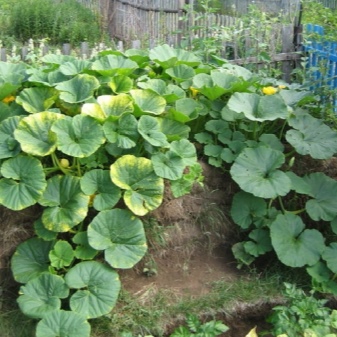
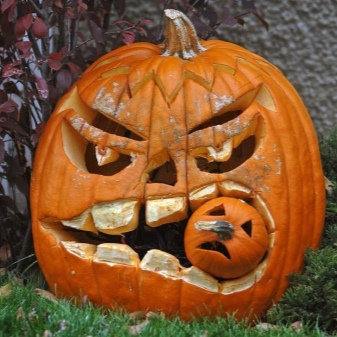
In the gardens of professional florists, you can find vertical flower beds. This is an artificially raised container for plants, where climbing or liana-like plantations are planted. This can create a wave or waterfall effect. In turn, it is also easy and pleasant to look after them and there is no need to bend over and bend over to them.
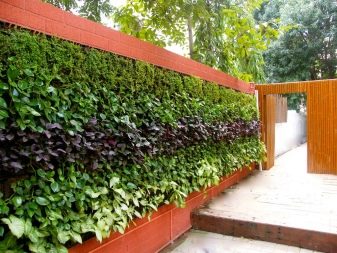
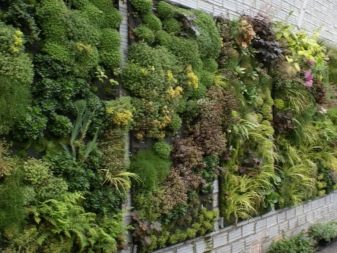
According to the species diversity, flower beds can be divided into monoclumbas and panels:
Monoclumba differ in that they contain flowers of almost the same color tone, or only a certain type of flowers. For example, a flower bed can only be planted with roses, tulips or chrysanthemums.
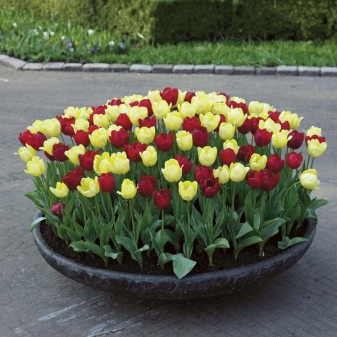
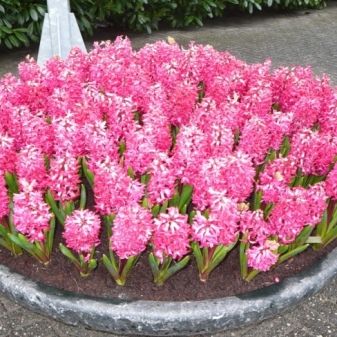
Flowerbed-panels used to create a drawing. If even a beginner can cope with the creation of the above flowerbed, then a certain level of knowledge and skills is required. The main purpose is to lay out a certain pattern (for example, a clock or a cartoon character's face, a flower shape, etc.).
Dwarf or undersized shrubs and perennials are used as plants. It can be violet, zinnia, erica, fuchsia.
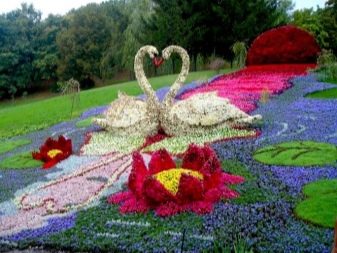

Most suitable for urban plantings are carpet beds... On them, patterns are created mainly from deciduous and low-growing bush plants with an unusual carved or colored leaf. They require careful and professional self-care, but the results are worth it.
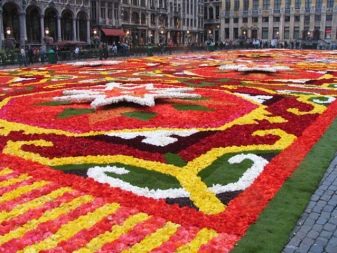
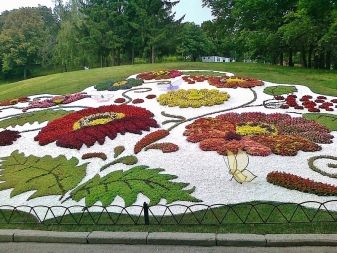
Original decor
In the world of landscape design, there is a wide variety of species of decorative elements for flower beds. The only limitation is your own imagination and, of course, the financial side of the issue, since this pleasure is by no means cheap.
Stones
Perhaps one of the easiest and most durable ways to decorate a flower garden is to use stones. Stones can be either purchased or found in nature. Often, gardeners pick up round pebbles on the stony seashores.
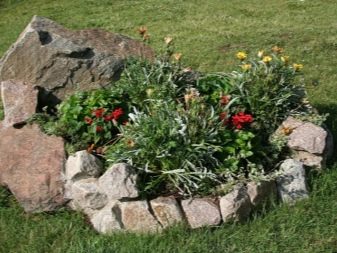
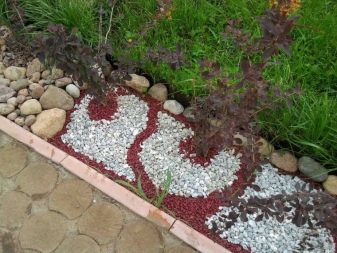
Some masters paint them with acrylic or oil paints, and then lay them out on flower beds so that an interesting pattern, curls or paths are obtained.
Recently, it has become fashionable to decorate the front garden with stones, which depict domestic or wild animals in a hyperrealistic version. It seems as if a real cat or hedgehog lay down by a beautiful bush of violets or asters.
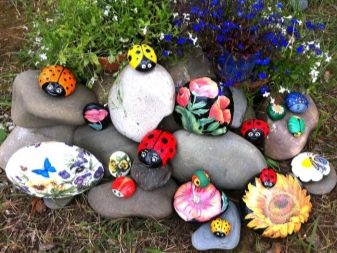
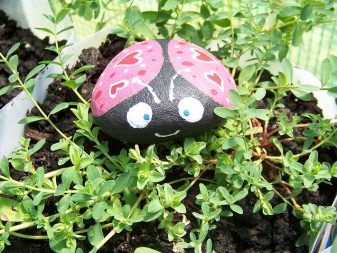
Materials at hand
You can make a decoration for free and without the use of building materials. Land owners take a metal mesh and make a voluminous, but hollow inside fence or fence for the beds. Further, the entire internal space is filled with a beautiful stone (the same pebbles, sometimes even mixed with shells or decorative glass balls).
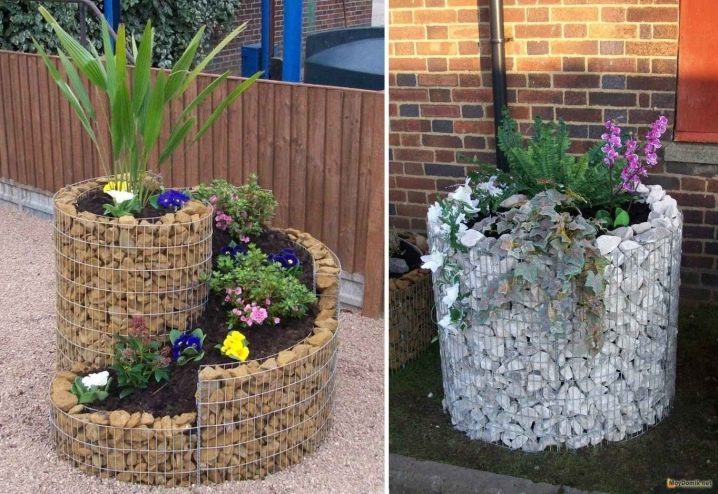
Concrete
Professional designers often use concrete paths in their projects. They are laid in parks, summer cottages, vegetable gardens, etc. It is easy to move along them without getting your feet dirty.
You can make or purchase special flower beds for flower beds from concrete. They are different in height, and also have different shapes (circle, square, hexagon, etc.).
Such devices look very beautiful and laconic in a flower garden, creating an additional effect of neatness and cleanliness on the site.
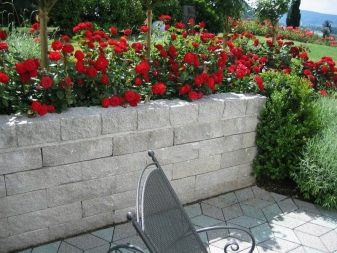

Decorative paths in the form of burdock leaves are often made of concrete. To do this, take a large burdock leaf, apply a layer of concrete mortar on it and wait for it to dry. The result is stone burdock leaves with veins like a real leaf.
For more realism, they can be painted with spray paint, and the details can be drawn with a thin brush.
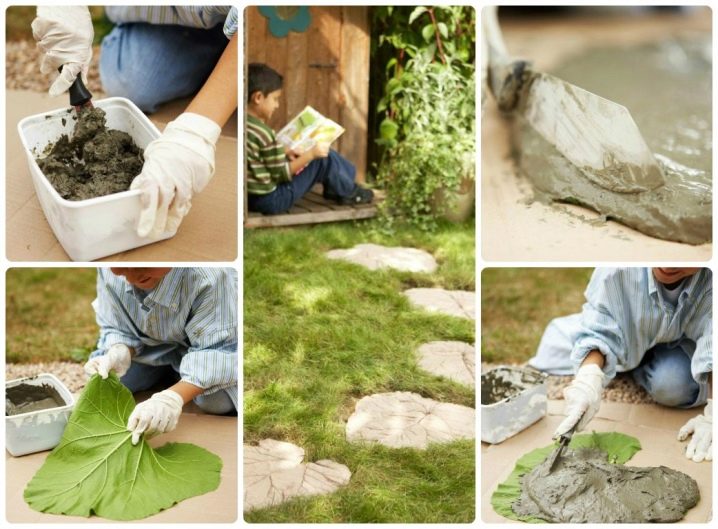
Cink Steel
As a fence for flower beds, metal galvanized canvases are purchased, from which it is easy to assemble a flower garden of any shape. It can be a hexagon, rectangle, triangle. Their plus is that they are lightweight and durable. Such bumpers will last a long time, they can change color every year.
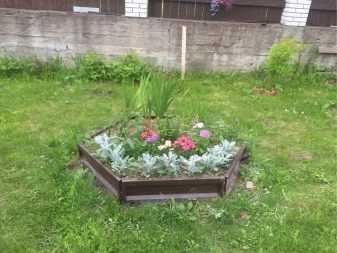

Brick
An ordinary brick can be an excellent assistant in the decor.It is easy to make a decorative frame from it for a flower bed of any shape. Most often, gardeners lay out a brick with an upward angle., then the "fence" turns out to be very unusual and embossed.
If you plan to make a tiered flower bed, then you can line the borders of the upward tiers with bricks, which will give even more charm and neatness to the flower bed.
For beauty, you can alternate them in color, but if this is not possible, then it is better to purchase white bricks and paint them with spray paint.
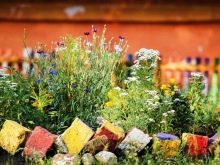
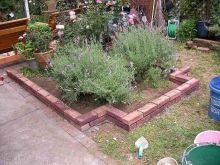
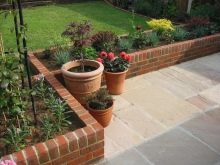
Weaving art
A very unusual and as close to nature as possible way is to decorate flower beds with wicker fences. Wicker fences are made very simply, although this labor is painstaking.
This requires small wooden pegs, and thin twigs of birch, willow, grape vine, pussy willow and even raspberries are suitable as a twig... With their help, you can create truly unique and non-standard flower beds with an ornate pattern. Such "live" decor will always delight the eye with its uniqueness and uniqueness of form.
Sometimes balls of thick twine are acquired as a braid... It will last a long time and will help keep tree branches in place.
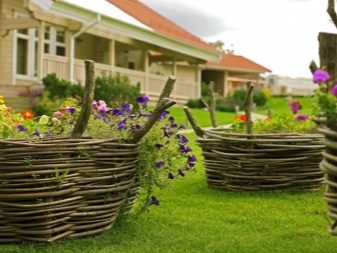
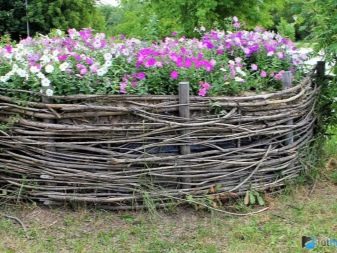
A flower bed is the main decoration
For decorative purposes, a flower bed can take on very unusual "poses". One of these options is to install a flower bed in the form of a fountain. The design itself is simple, but requires careful selection of place and colors. Sometimes large bowls with earth are placed in a functioning fountain, which looks very impressive.
The flowerbed itself is a decoration of a garden or park, so its shape can also be non-standard. They break up flower beds in the form of a butterfly, sun, a simple flower and use other options.
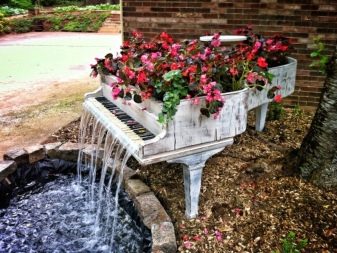
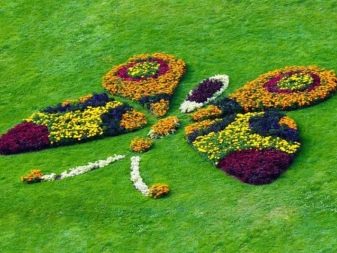
Decorative figurines and figurines
Plaster figures of various sizes are used as decorating elements. These can be garden gnomes, mushrooms, birds, kittens or any other animals. Some craftsmen purchase plaster blanks and paint them on their own. This method will cost less, moreover, it is always pleasant to look at the fruits of your creativity.
The most important thing is to maintain a balance and not overdo it in filling with decorative elements, otherwise the flower bed will look tasteless.
In the field of landscape design, something new and unusual always appears from various materials. Sometimes things that are completely incompatible with the flower bed are used as raw materials, but in fact, a very effective design solution comes out of them.
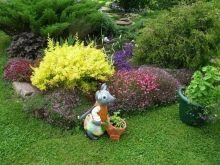
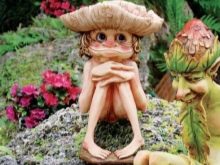
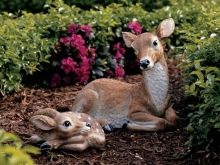
Plastic and glass bottles
One of the cheapest and most affordable decoration options is regular plastic bottles. From them, in skillful hands, beautiful birds or animals can be obtained. Also, this material will make a practical fence for a flower bed.
To waste less time on watering, you can bury the container halfway in the ground with a special hole and fill it with water. The roots of plants will slowly drink it, saving their owner from unnecessary work.
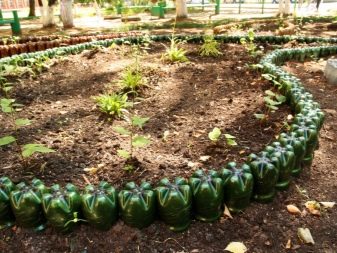
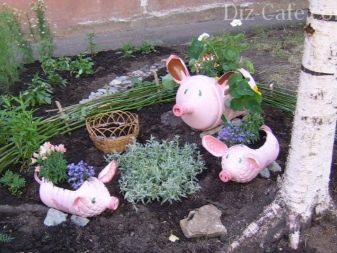
In some areas there are flower beds made of glass bottles. To fix them with each other, all the same concrete is used. With their help, flower beds of various shapes are made. The most important thing is that the glass is clean and solid (blue, green, yellow).
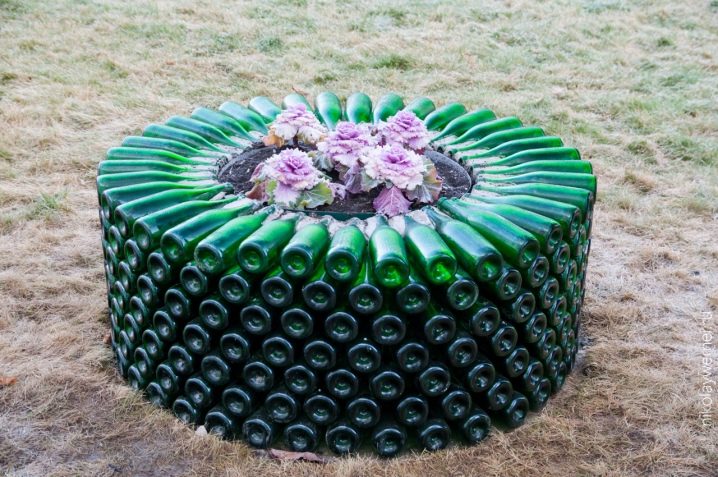
Tires
For street beds, old tires are a great solution. We have all met such flower beds more than once. To make them look original and aesthetically pleasing, they should be well washed and painted.
Often they make swans, where the main body is a flower bed, and the head and wings are made of a tire, which also pleases people passing by and the master gardener himself.
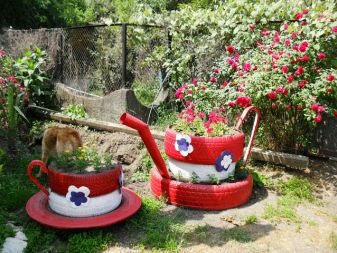
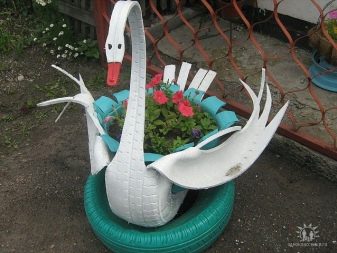
New life of old things
Unusual materials can be used to decorate flower beds. It could be an old umbrella or a leaky metal bucket. The umbrella is turned upside down and the earth is poured into it, where plants are very easily planted.
If the handle has a hooked end, then it can be hung, resulting in a hanging flower bed.
Original the flowerbed can be made from metal or plastic buckets... They are often arranged in a pyramid so that the flowers hang down to the bottom rows, or they are arranged in a row so that the colors repeat the rainbow. The only limitation here is your own imagination.
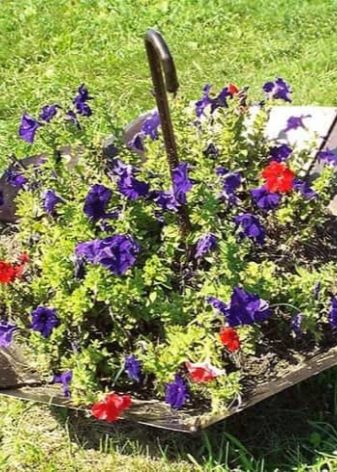
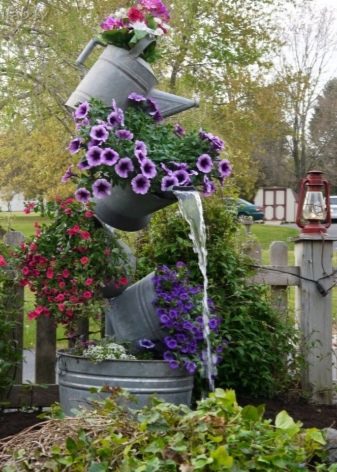
An excellent starting material for creative ideas can be wooden pallets or wooden boxes. It is easy to create a compositional flowerbed from them in the form of a steam locomotive or a stepped pyramid.
If there is an old unnecessary chest of drawers of small size, then it can also be used. All the boxes are pulled out, filled with earth and your favorite flowers are planted there, the result is a very original flower bed.
It is very important that all boxes are treated with varnish or a solution that does not allow the wood to swell, and even better, cover the bottom with oilcloth. But holes in it will have to be made, since the water can stagnate and lead to rotting of the roots.
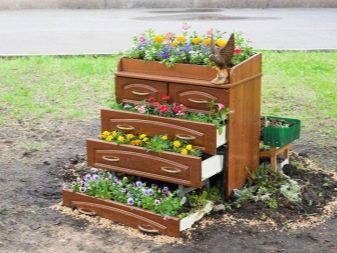
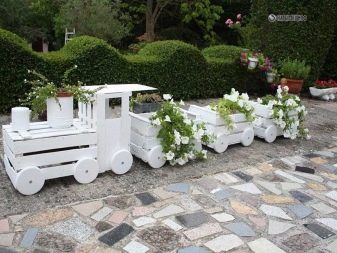
For a large area, the flower bed should be of the appropriate size. Fans of non-standard design take into the business boats, out of use baths, suitcases, bicycles and even old cars that have already left their term.
The bike is usually painted in a solid color and baskets or boxes with soil are placed on it, where seeds can be planted.
As for the boat or car, then it is worth considering the fact that you will have to take care of the objects too, since wood swells and creeps from moisture, and metal is susceptible to corrosion for the same reasons.
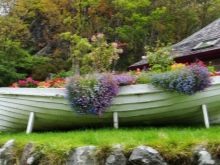
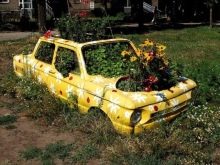

Lawn
A good way to separate some flowers from others in a flower garden is to use a lawn. Concentric circles of planted flowers of bright shades are beautifully combined with green spaces between them.
The most important thing is to maintain the water balance, because green grass requires an amount of water that is different from the watering requirements of flowers.

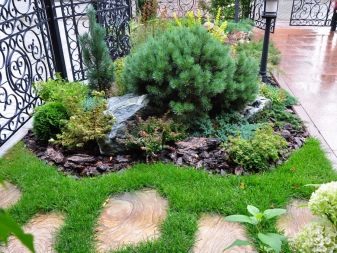
Everything for convenience
For those who do not want to bend over again for watering and cleaning, there is an opportunity to create a wall hanging flower bed from an ordinary wooden pallet. It is attached to the wall with dowels. It can also be wooden shelves. It is advisable to insert plastic pots into special compartments so that the load is less. Then flowers, small in height, are planted so that they do not block the sunlight to each other.
This design is convenient for several reasons: firstly, it is easy to hide the imperfections of the wall, and secondly, it is easy to care for the plants and periodically change the pots in places.
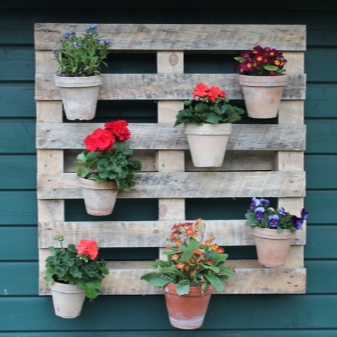
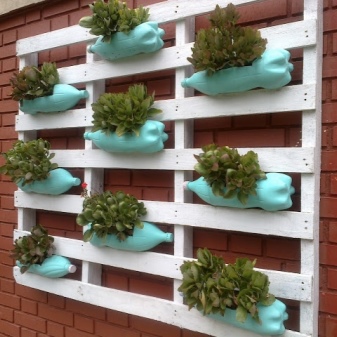
Landscape designers persuading people to reuse plastic and glass bottles make the flower bed a very interesting way. A side hole is cut in the container so that the flower can fit there. Then it is suspended by the ends on a string and placed on the wall using self-tapping screws. The drawing and diagram of their location can be any (in the form of steps, checkerboard, ring or animal outline).
The original design and decoration of flower beds should be simple and at the same time elegant, so that in such a garden you would like to rest your body and soul. For each of the items, proper care must also be carried out - cleaning from dirt and dust, so that the flower garden pleases with its freshness and colors.
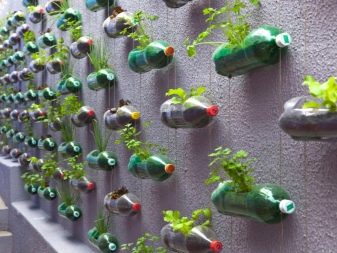
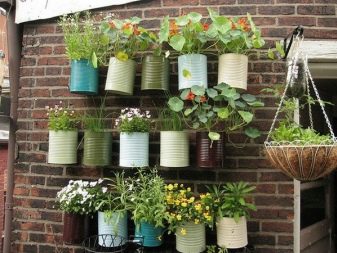
Where to locate?
The location of the flower bed must be chosen very carefully. First of all, it must be clearly visible in order to fulfill its original task - to satisfy the aesthetic needs of the owners.
If the flowerbed is located somewhere in the corner of the site, then there will be no special sense in its location. Of course, you can put a bench next to it and go out to admire it, but in a cool time it is always more pleasant to contemplate the beauty from a warm house than from the street.
In this regard, the best position for her will be a place by the window, next to the gazebo, near the gate, or next to the benches.
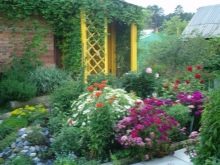
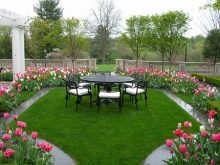
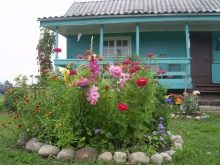
The second important aspect is sunlight. Daylight hours should cover the sown plot of land as long as possible, since this is the basis for full flowering. But then you need to plant light-loving plants, otherwise they can simply "burn out" from bright rays.

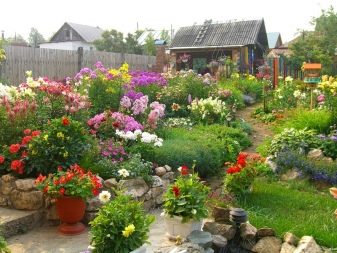
And the third aspect of choosing a place for a flower bed is soil moisture. It's safe to say that this factor is much more important than light.
If shade-loving plants can somehow come to terms with bright light, then they will not be able to put up with excess moisture. It is best if the soil is slightly dry and crumbly., since it is always better to water it once more than the roots will rot in the mud.
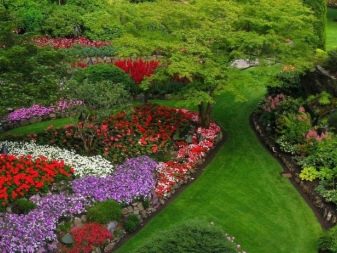
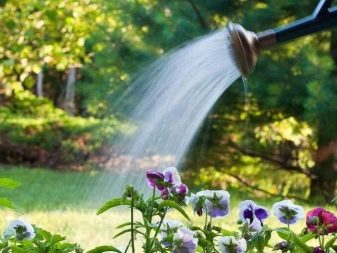
In most cases, a flower bed is broken up almost in the middle of the land plot allocated for a flower garden, or it extends in a narrow strip along the fence or wall of the house.
Some fans of planting flower beds "in a big way" make it almost for the entire site. It can be some kind of selected ornament or drawing, but this will take a lot of effort.
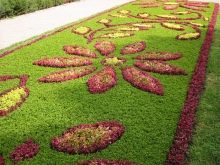
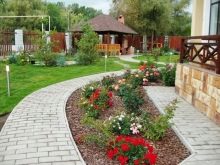
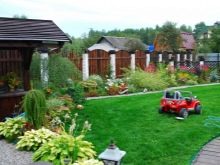
Elongated flower beds with an approximate width of 1-1.5 m are located, as a rule, along the entire length of the fence line (either inside the site or outside; there are often cases when both here and there). Such flower beds are called a rabatka.
Forms may also vary. The standard is a circle, oval or square flower bed... Due to their simplicity, you can alternate them with lawn paths, but the main thing is to keep a distance so that the roots of flowers and grass do not connect.
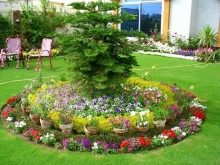
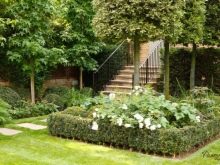

Popular schemes
For lovers of gardening, and landscape design in general, it is difficult to immediately draw the initial scheme of the future flower bed, and especially to make the correct selection of flowers. In this case, the masters advise to use the experience and learn this skill from people who already have enough knowledge in this matter.
Personal experience can be gained through trial and error, probing all the pitfalls in floriculture empirically.
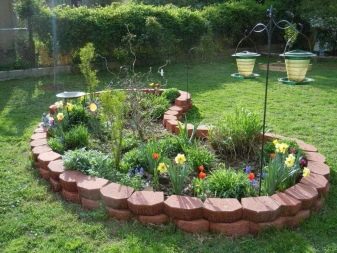
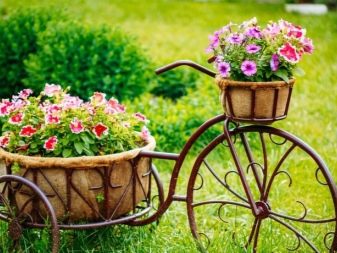
As for the pattern on the flowerbed, it largely depends on its shape, location and purpose. There are also a number of rules that should be considered:
- The tallest and most bushy flowers and shrubs should stand in the center of the flower bed, and the undersized ones should be placed closer to the edge. This will show all the plants. They will not be able to shadow each other.
- In the flower garden, you need to make a color accent, and not plant all the colors of the rainbow interspersed. The ideal option would be a combination of silvery-green, almost white bushes next to bright ones. Due to this, their beauty is even more emphasized, and the drawing will be even clearer.
- In the front rows of the flower bed, you should not plant annuals, since at the time when they fade, the place on the ground will be empty and spoil the general appearance. Therefore, experts advise planting the same tulips or daffodils next to lush perennials that will obscure the empty space.

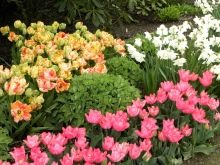

For a round flower garden, there are a large number of scheme options. The most common are the usual concentric circles. Plants can be planted in layers, from center to edge, or in an even canvas, but have alternating colors in the shape of a circle.
The second option is most preferable in parks. For these purposes, you can use petunias, marigolds or any other undersized flowers. You can even use different colors of the same plant.
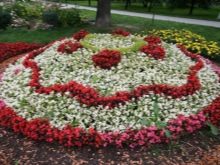
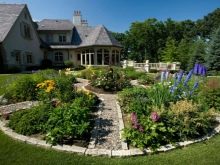
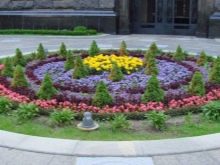
In a round flower garden, the conical arrangement of flowers looks very successful and unusual. As a rule, this is an artificially raised flower bed, where each tier is separated from the other by a partition or stones.
The second most popular is the imitation of a simple flower with five petals. Phlox are great here. The diagram of the heart, as well as uncomplicated spirals, will look good.
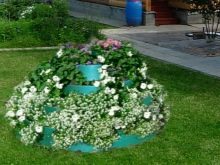
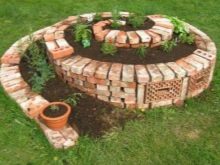
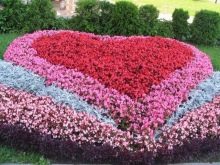
For a square flower bed, it is better to choose straight and clear patterns so as not to violate the basic geometry.These can be simple parallel beds that will resemble a striped carpet, or diagonals coming from the center.
The drawing resembling a chessboard is very beautiful and pleasing to the eye. Of course, you will have to spend a lot of time, but the result will be worth it.
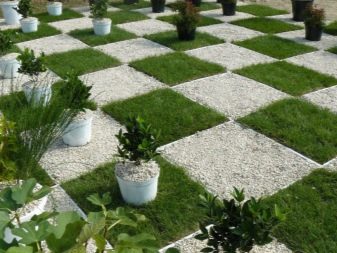
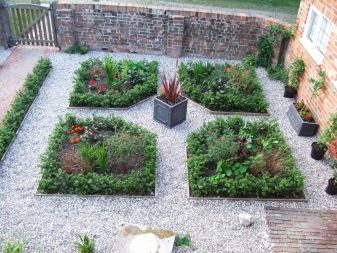
Schemes are interesting where there are combinations of shapes, for example, a square in a circle or vice versa. Their creation is also painstaking work, but it will be appreciated.
For flower beds without outlined forms, island-type schemes are best suited, where the rows can mirror each other or aesthetic chaos will dominate at all.

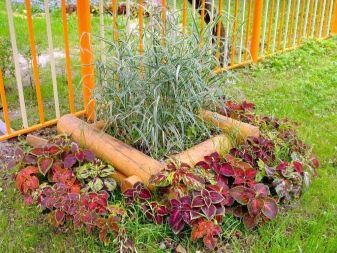
For a hanging or vertical flower bed, schemes can also repeat a checkerboard, have even alternating stripes, circles replacing each other in color. It all depends on its scale and size.
In any flower garden, you can adhere to a certain scheme, but as experienced florist designers advise, every year you need to try to change forms so that this business continues to be an art and an expression of the inner state of the soul, because each flower has a certain meaning and symbolism.
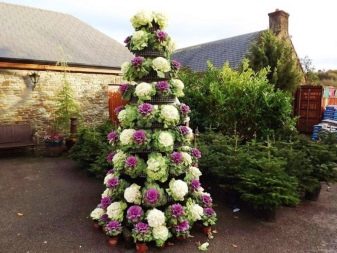
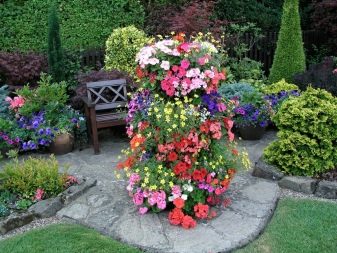
Soil preparation and planting
After the gardener has chosen a certain place for the flower bed, drew a future diagram, it is necessary to do a certain series of manipulations with the ground so that beautiful and lush flowers grow on it.
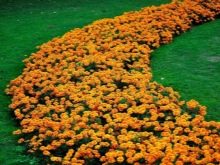
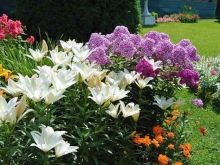
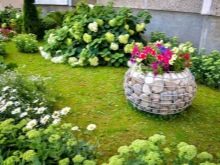
Primary training
First, you need to clear the soil from construction debris, if any, and also remove all weeds and large clods of earth with stones. They will be a serious hindrance to the development of the root system of plants.
During the work, builders bury the remnants of bricks and concrete in the ground. They also need to be dug up and removed from the site, since in the cold season the ground freezes deep enough, and the stone draws out heat, thus the remaining perennials and shrubs (for example, lilacs, thuja) may die.
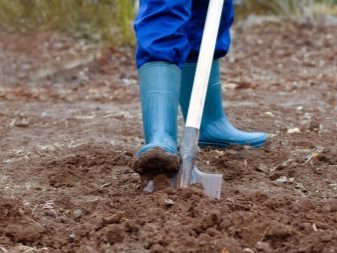
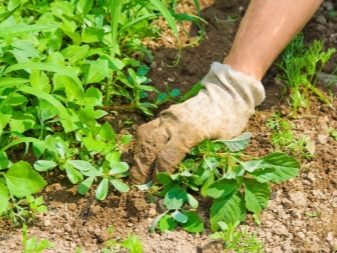
Composition assessment
Can land clean of garbage be considered fertile? Not always. The most suitable for the growth and development of flowers and plants in general are loamy soils, which are rich in peat and humus. A small amount of clay will be a big plus, since it turns into a viscous slurry after watering, and then dries up with a hard crust, which must be broken up and loosened.
Therefore, it is necessary to assess the composition of the available land. Ideally, the depth of the fertile layer should be approximately 30-45 cm... In flower shops and agricultural markets there are ready-made potting mixes for a certain type of plants and flowers.
Experienced gardeners are advised to dig up a layer of unusable soil and replace it entirely with new soil. It should be loose, soft and sufficiently moist.
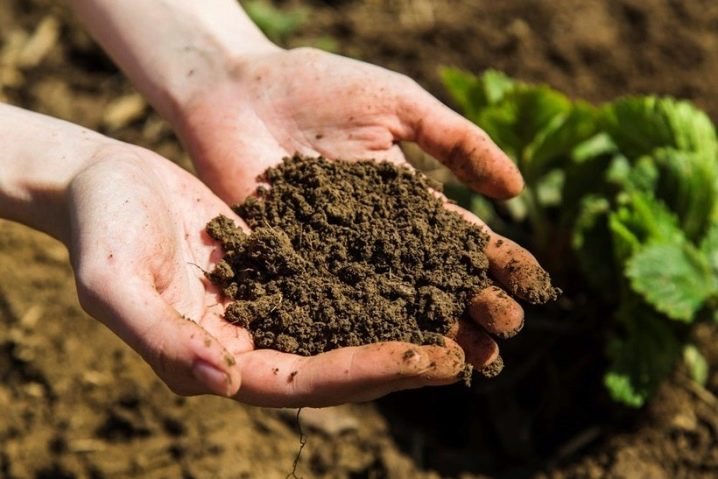
Fertilizer
Do not forget about such a moment as compost, which is one of the most urgent and effective options for improving the water-mineral composition of the soil.
It can be purchased either ready-made in the store, or you can make it yourself. To make it organic household waste is fine (shells from eggs, husks from seeds, kitchen leftovers), weeds that were picked from the ground, leaves from harvesting.
The most important thing is not to put diseased roots or branches in a vat with humus, as the disease can spread to all plants in the flower bed.
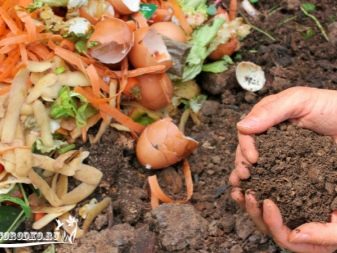
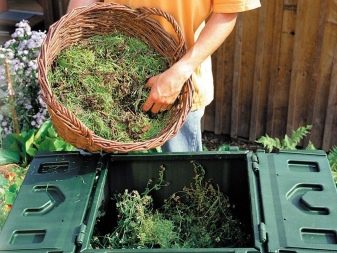
Organization of space
The next step will be to line the prepared land for future plantings. It is about preparing the beds where the seedlings or seeds will be planted.
The beds are dug in a pre-selected pattern (concentric circles, squares, even stripes, etc.). It is very important that the ridge is 15-20 cm deep, otherwise it will be difficult for the root to catch on and further hold the main body of the flower.
You also need to know the so-called "comfort zone" of the plant. It depends on the type of its roots and how widely and deeply they spread during the growth process (there are roots that grow into the depth of the soil, and there are those that create a dense horizontal "network"). Ideally, each flower "body" is planted at a distance of 7-12 cm from the next... So the flowers will be given the opportunity to grow and develop freely. Nearby "neighbors" will not create unnecessary shade, as well as take away vital moisture and nutrients.
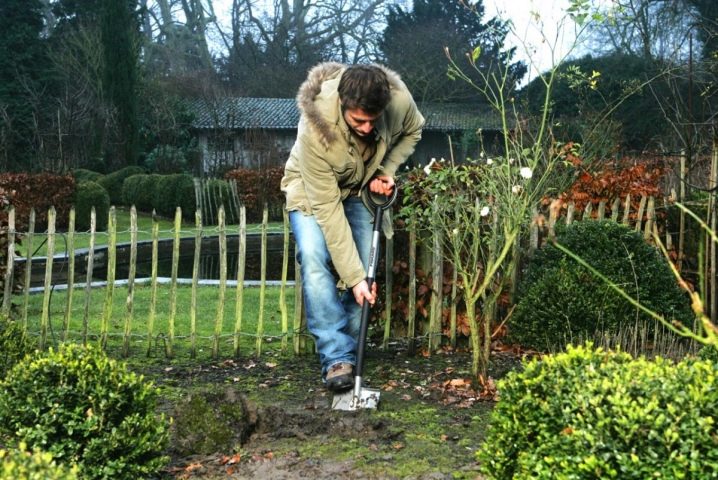
Planting features
Before direct planting, it is necessary to shed all the beds well and it would be nice to fertilize the soil. Seedlings are also spilled in large quantities with water so that they can be easily removed from plastic containers, but best if prepared in peat pots. The plant is planted in the soil with it... With this option, the roots do not suffer from a change in place and develop better.
The flower is planted in a prepared hole or bed and carefully sprinkled with earth. The main thing is not to "strangle" the roots, that is, you do not need to tamp and press them with your hands.
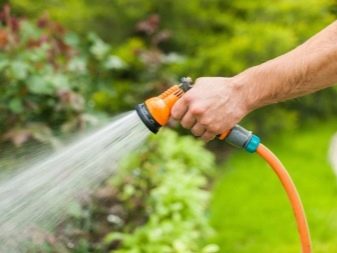
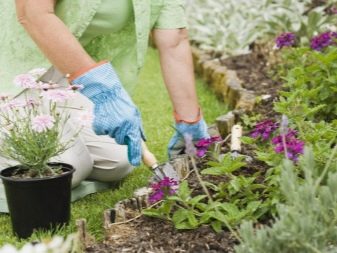
If it was decided to sow the seeds with seeds, then it is better to soak them in water 5-6 hours before immersion in the soil. So it will be easier for them to push apart the chitinous membrane and start up the cotyledons for the development of the first two leaves.
Seeds are placed in the soil to a depth of 5-7 cm and also sprinkledto make it easier for them to emerge (the thicker the earthen layer on top, the more difficult it is for the first two leaves to break through to the light).
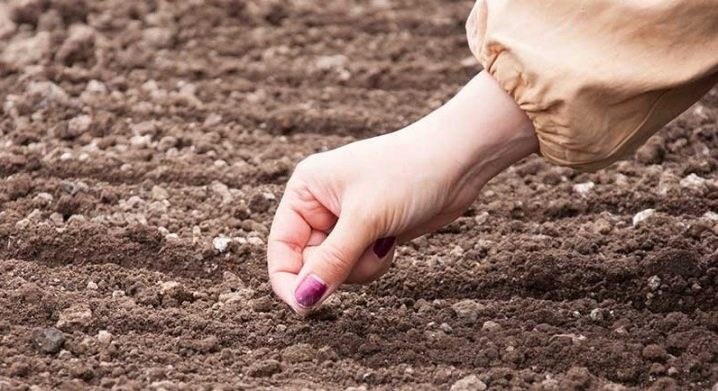
Further care
After the seeds or seedlings are moved to the flower bed, they should be well watered. Novice gardeners often make the same mistake - they water only the top layer of the earth, while it is necessary to carry out high-quality watering! Firstly, water will give strength to the plant, and, secondly, it will strengthen the location of each root (when moisture seeps into deeper layers, it kind of presses the upper ones, this helps to fix the young flower in place).
It is worth noting the fact that seed beds must be watered with care. A powerful stream of water can wash out the newly laid seeds from the ground, so half of the seedlings will not appear. It is best to use a watering can for these purposes.... Thanks to its spout, the jet breaks up into drops and does not harm young plants.
An automatic watering system will be a good helper in this matter. Special nozzles rotate quickly, due to this, the drop of water becomes even smaller, so the soil is gradually saturated with water and puddles do not form there, due to which subsidence in the ground appears.

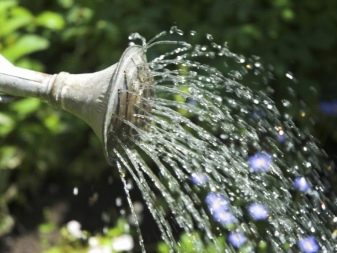
Which plants to choose?
The selection of flowering plants for your own flower bed is not as easy as it seems at first glance. Flowers need to be selected not only based on their own preferences, but also from considerations of the appropriateness of the plant for a given flower bed.
If it is difficult to make a choice, then the simplest solution in this matter would be to determine the color range of flowering plants. It has long been known that color affects a person's mood and performance, so it is very important to choose the most pleasant shade for yourself.
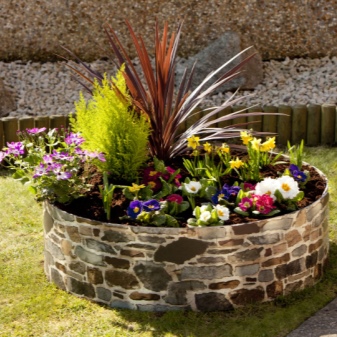
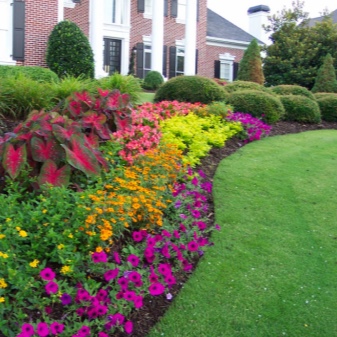
Beds and flower beds with dominant red, orange and yellow colors can cause some internal irritation, excitement when looking at them for a long time.
If these are blue, white or purple tones, then they have the opposite effect on the emotional mood. They can calm and relax.
In this regard, landscape designers are advised to combine these colors in the correct proportions. You can alternate beds with different colors. The most acceptable combinations are purple with yellow (and their variations), red with green, blue with orange, white with red, etc.
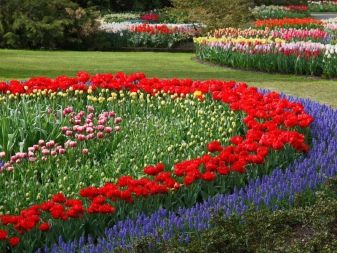
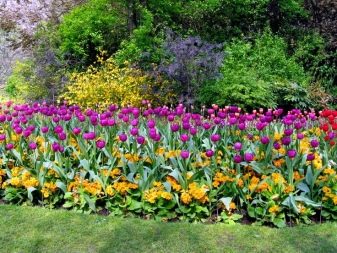
When choosing a palette, you need to take into account the illumination of the area on which the flower bed will be located. If it is on the sunny side, then blue, white and violet colors will look very beautiful and natural., but if they are in the shadow part, they will immediately lose their charm and they will be practically invisible.
You also need to take into account the "class" of the flower and, in accordance with it, plant it either near the gate, or near a tree, next to the house, or in the most conspicuous place in the garden.
If it is a peony rose, eustoma, hydrangea or gloriosa, then they are not supposed to grow "by status" at the gate or somewhere in the backyard, they should have a dominant place.
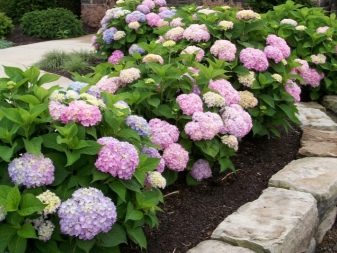
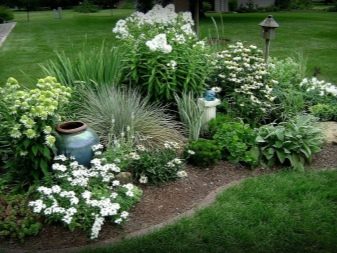
The entire family of flowers and plants is divided into two large groups - annuals and perennials. From their name it is clear that some of them can bloom for several seasons and do not require another planting every spring. Others, in turn, bloom their summer and end it by "issuing" seeds that need to be planted back into the soil.
Each type has its own pros and cons. Therefore, it is best when both types of flowers are found in the flower bed, since annuals have a longer flowering period than perennials.
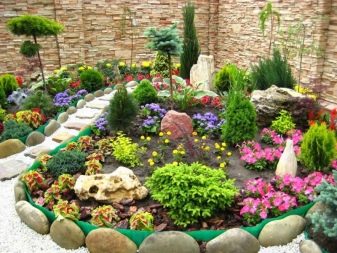

The most a simple solution can be ordinary roses or spray, daylilies... But in winter, they must be protected from the cold by covering them with a special material. They can bloom for several years in a row.
A good option would be to plant a statice or, as the people call her, the immortelle. There are both perennial and annual species of this flower. It has different shades and begins to bloom almost from May.
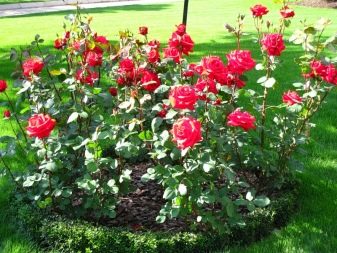
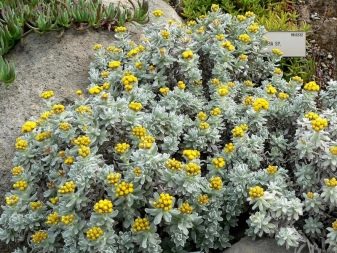
Highly often the basis of a flower bed is geyhera... It is unique in that it has a wide variety of bright shades (burgundy, yellow), is a good "neighbor" for many cultures, and can occupy a central place in a flower garden.
From annuals, you can choose petunia, marigolds, epomea, zinnia... They are always appropriate for any flower bed and give only positive emotions when you look at them or inhale a pleasant floral scent. The advantage of these colors is that you can change them every year, experiment with colors and find new suitable combinations.
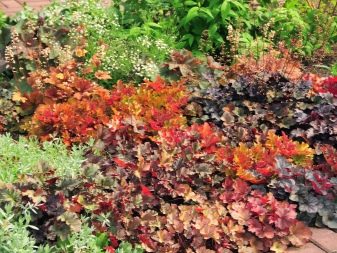
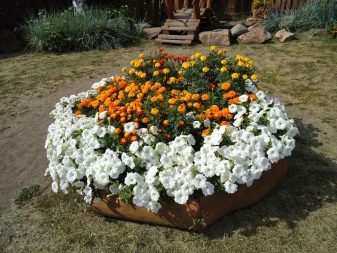
Flowers should be selected based on the parameters of the flower bed itself. The most common type is the mixborder. It is characterized by irregular shapes and the presence of large plants. As the main or leading can be any shrub or bonsai, apple or pear.
In such flower beds, a combination of annual and perennial flowers and shrubs is appropriate so that they bloom throughout the year, replacing each other.
In the center, you can plant clematis, oriental thuja or boxwood, then there can be a multileaf, decorative wormwood, lavender, followed by coreopsis or cinquefoil. Tungus clematis will stand well in the back rows.

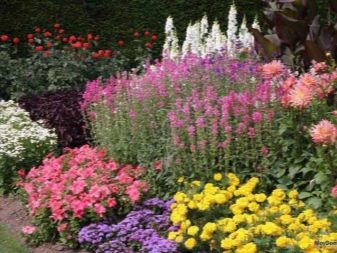
For flower gardens such as rockeries, the color matching should be slightly different. Here they should be small in size, and also be combined with stones, which must be present in the flower bed. Eringium will look good here, which has shades of blue and silver, bell, snowdrops, irises, primrose, various kinds of phlox.
With proper planting, these flowers will delight you with their lush flowering and unpretentious care.
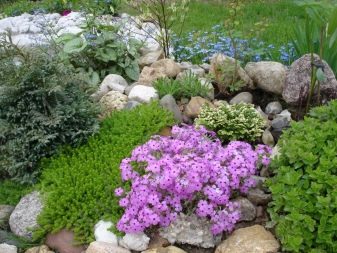
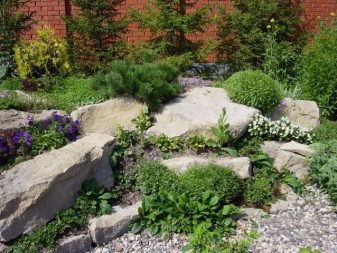
For regular flower beds, annual flowers such as marigolds or petunias are suitable.... Tulips or daffodils will look good. Low-growing shrubs are also preferred.
The choice of flowers for vertical flower beds is specific. Since they are generally small, the plants should also be bright. Often choose one-year begonia, petunia, capuchins.
The flowerbed looks especially impressive when they grow strongly and hang slightly below the edge of the pot.
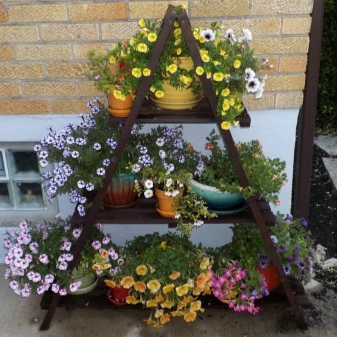
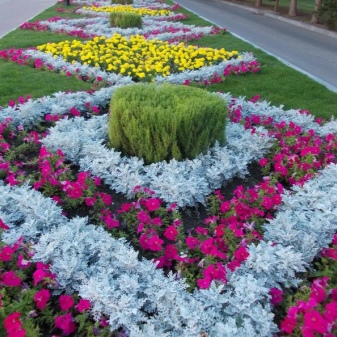
For parterres, it is necessary to have some kind of pattern or pattern, therefore, it is necessary to choose bush color options, from which you can create something more.
If there is not much experience in caring for the garden, then it is worth starting to ennoble the flower beds with something simple and uncomplicated. Better to start with several varieties of the same flower and try to experiment with them.... If the result is positive, then you can already complicate your task for the next year.The most important thing is that this activity brings pleasure and emotional relaxation.
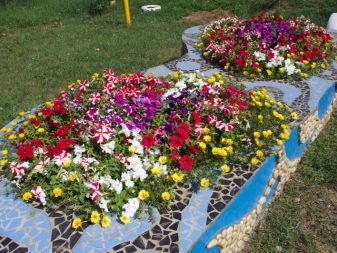

Professional advice
Professionals in any area are not born, they become, after going through the path of trial and error. There is always something to learn in landscape design, so you need to constantly be interested in the experience of people who make beautiful flower beds and flower beds with their own hands.
There are branches in this art - this is the very design of the flower beds, the care of plants and the selection of flowers.
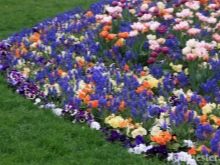

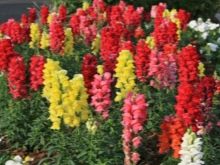
All masters, without exception, advise to always draw a future planting plan on paper. Some gardeners make a layout of a flower bed on a Whatman paper, marking on it the main pattern or layout to scale. They mark where communications will be carried out (for example, an automatic irrigation system), the location of a decorative groove or any other objects. Then they mark what and where the plant will be planted, as well as the approximate dates of work in order to understand the amount of work to be done.
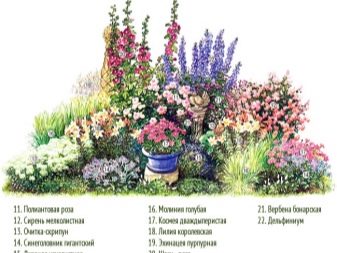
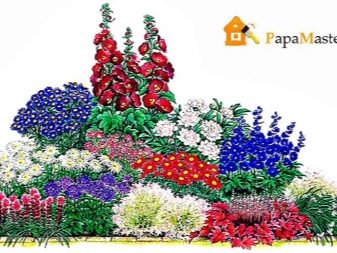
Do not forget that each flower or shrub has its own specific biological clock, which must be adhered to, otherwise late-planted annuals may simply not rise. When according to the plan you need to create a regular flower bed, where there should be constant flowering, it is impossible not to comply with the terms of planting and cleaning, because then it will look very unkempt and have "bald spots", which should not be with proper care.
Also it is necessary to maintain a schedule of watering, planned feeding and preventive treatment against root and leaf parasitesv. If an infected flower was noticed, then it is better to urgently isolate (dig up) and disinfect the ground.
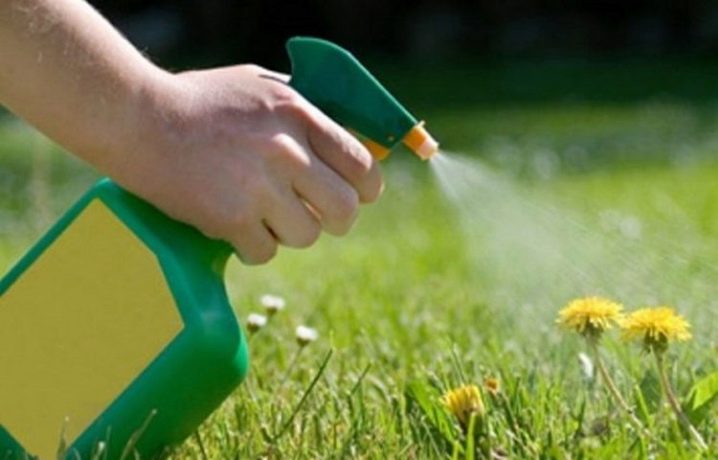
Inexperienced gardeners often make mistakes such as non-observance of light preference in plants... As you know, there are lovers of the shade and the sunny side. Flowerbeds can not always be located only in well-lit places, but also in the "dark" corners of the site.
A side is considered shaded if the sun's rays are on it for about 2-3 hours, and the rest of the day there is only diffused light. Here you can plant a forget-me-not, hostu, fern, rhododendron... They will perfectly tolerate these conditions, as well as delight with their beauty.
The completely shady side implies finding the flower garden under the crowns of trees, which create a dense curtain from the sun. It should be understood that a special microclimate is formed here and there will be high humidity. For such places, kupena, begonia, periwinkle, and clefthoof are suitable.
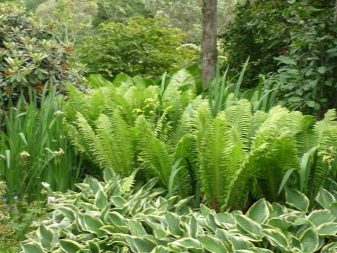

Landscaping professionals advise to pay special attention to the selection of ready-made seedlings and seeds. Almost 60% of success depends on this.
When planting seedlings, you need to see how the earth behaves if you get the plant out of the pot. The rhizome should be kept in a dense lump, and the earth should adhere well to it and not crumble. The soil is supposed to be slightly moistened, not overdried.... Small hairs on the roots that absorb water must always be in the ground, otherwise there is a great risk that the flower will not take root.
The next step is to take a close look at the plant's body itself. The stem and leaves should be firm, free from damage or painful spots.... The color is natural, not dull, without dry ends.
As for the seeds, the first thing to look at is their expiration date. Seeds in capsules are considered to be of higher quality, so the period for planting them increases, they do not damp and do not rot.
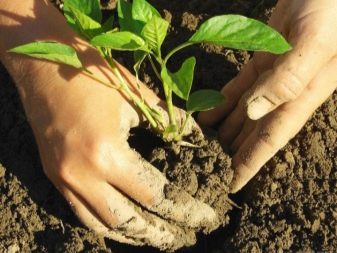
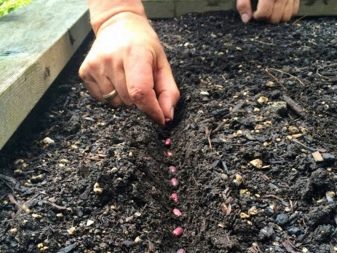
Any flower bed has its own specific style. Experienced flower growers advise using their decoration of concrete products, since, firstly, they have a long service life, are not subject to decay and tolerate moisture well. Secondly, concrete is a fairly plastic material that can be poured into molds and various figures, borders and even paths can be made.
This material is environmentally friendly and will not damage flowers and earth.... Also, its big plus is its low cost. Also, concrete is not subject to combustion.


If we talk about choosing a shape for a flower bed, then there are no tips as such. It can be arranged as triangular, round, hexagonal or square, most importantly, to please the owner.
Of course, it is better to start with simple shapes in order to gain experience in building a flower arrangement in a flower garden.
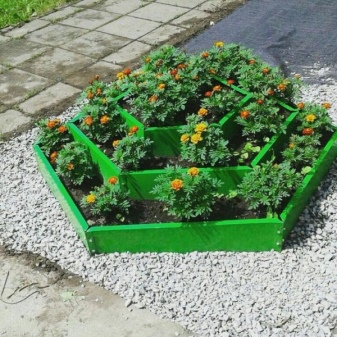
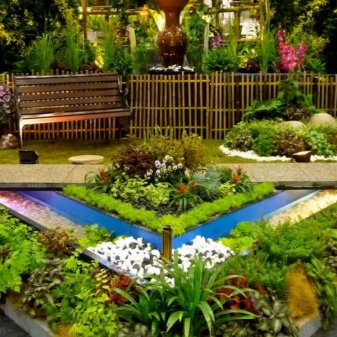
Beautiful examples
Today there are a huge number of decorative flower beds that can be an inspiration for creating your own flower garden.
- Rather tall plants have been selected here. They are planted in a cascade and do not interfere with each other. The colors are all quite bright, but they are beautifully combined with each other, thanks to this, the flower bed is perceived as indivisible.
- From ordinary wooden boards, you can create a truly unique flower bed. It can take completely different forms. Thanks to the use of natural material, the flower garden looks even more romantic and dear.
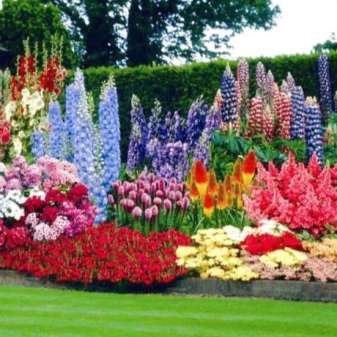

- This photo shows a very good location - in front of a window. Clear boundaries, regular shapes and elegant colors will cheer up its owner every morning. It is worth noting that for such a flower bed you will have to carry out rather painstaking care, but the result is worth it.
- This is one of those examples where fantasy knows no boundaries. How much work has been put into this machine! The combination of simple colors and complex shapes results in a masterpiece of landscape design.
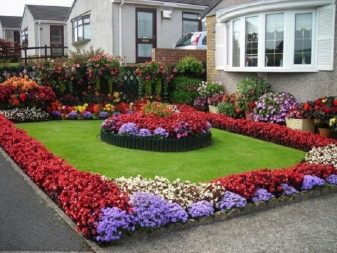
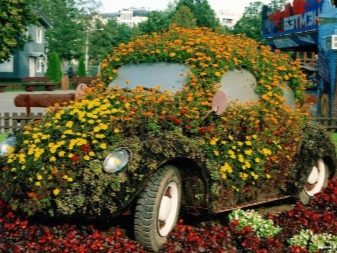
- It may seem that this form is quite simple, but to achieve it, you will have to exert a lot of effort. A beautiful combination of pale pink flowers with an inner burgundy edging set off the light blue core.
- Thanks to the correct selection of colors, it seems that this is a real swan floating on the blue waters of the lake. Due to the fact that the flowers grow with a slight difference in height, a complete imitation of the water in the lake is created in the yard, where "reeds" grow along the shore.
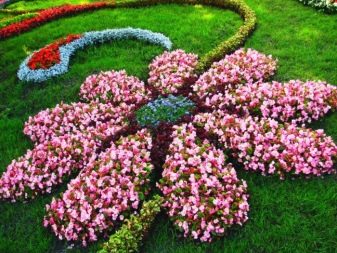
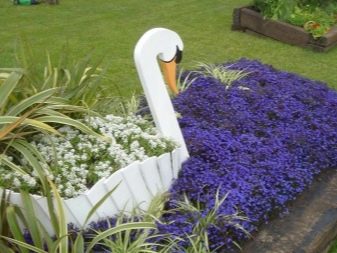
In choosing a decor and shape for a flower garden, the most important thing is not to be afraid to experiment, then from year to year the flower beds will be filled with more and more unusual shapes and colors.
For information on how to make a transformer flower bed with your own hands, see the next video.







































































































The comment was sent successfully.